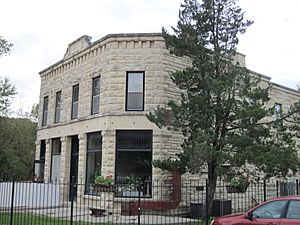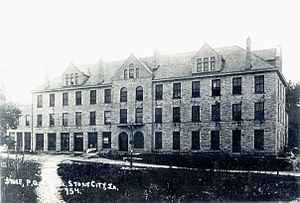Stone City, Iowa facts for kids
Quick facts for kids
Stone City, Iowa
|
|
|---|---|

General store, Stone City
|
|
| Country | |
| State | |
| County | Jones |
| Area | |
| • Total | 1.81 sq mi (4.70 km2) |
| • Land | 1.76 sq mi (4.55 km2) |
| • Water | 0.06 sq mi (0.15 km2) |
| Elevation | 820 ft (250 m) |
| Population
(2020)
|
|
| • Total | 186 |
| • Density | 105.80/sq mi (40.85/km2) |
| Time zone | UTC-6 (Central (CST)) |
| • Summer (DST) | UTC-5 (CDT) |
| ZIP code |
52205
|
| Area code(s) | 319 |
| FIPS code | 19-75540 |
Stone City is a small community in Jones County, Iowa, United States. It started as a "company town," meaning it was built for people who worked in the local stone quarries. Stone City is famous for its special Anamosa Limestone quarries, its old buildings made of limestone, and an art colony that existed there in the 1930s.
In 2020, about 186 people lived in Stone City.
Contents
Discovering Stone City's Past
How Stone City Began (1850–1904)
Stone City was founded in 1850 next to the Wapsipinicon River. Early settlers found lots of dolomite and limestone in the area. At first, the place was called the Anamosa Quarries. Later, it became known as the Stone City Quarries.
In the late 1800s, three men named Henry Dearborn, John Green, and John Ronen opened limestone quarries here. As railroads grew across the country, it became easier to send limestone to other states. Stone City limestone was used to build railroad bridges, bridge supports, and foundations for large buildings. From 1859 to 1895, over 150,000 train car loads of limestone were shipped from Stone City every year.
As the quarry business grew, Stone City became a real town. Hundreds of people moved there. One of the first big buildings was Columbia Hall, a three-story hotel and opera house. It was finished in 1883 and built with 500,000 tons of stone. Famous entertainers performed there. By 1880, about 500 people lived in Stone City.
John Green, one of the quarry owners, built a huge twelve-room mansion overlooking the town. It had seven Italian marble fireplaces and hand-painted walls. After his house, Green built more of the town using stone. He added a railway station, a post office, a school, a blacksmith shop, a water tower, and many houses.
Changes and Challenges (1905–1950)
In 1905, a new building material called Portland cement started to be made in Waterloo, Iowa. This new cement was cheaper and easier to use than quarried stone. Because of this, the quarries in Stone City slowly began to close down. Over the next 50 years, nature started to take back many of the old quarry sites.
Columbia Hall was bought in the 1930s and taken apart in 1938 so its stone could be used elsewhere. The beautiful Green Mansion was badly damaged by a fire in 1963 and was later torn down in the 1990s.
The Stone City Art Colony
Stone City was also home to a special art colony for a short time. In 1932, famous artist Grant Wood, along with Edward Rowan and Adrian Dornbush, started the Stone City Art Colony. They rented 10 acres of land on the old Green Estate.
The Green Mansion was turned into a place for students to sleep. The rest of the house had offices, a kitchen, a sculpture studio, and showers. The basement of the ice house became a bar called The Sickle and Sheaf. The top part of the water tower was made into an apartment for Adrian Dornbush, which he called Adrian’s Tomb.
The art colony was very popular and had many students and a good reputation. However, it never made enough money to stay open.
Stone City Today (1950–Present)
Thanks to George Nissen, who invented the modern trampoline, some of Stone City's historic buildings were saved. The original three-story Stone Barn, the Quarry Office, Water Tower, and Ice House were all preserved. They have since been turned into private homes.
Many other old buildings like St. Joseph’s Catholic Church, the Schoolhouse, the General Store, the Dearborn Residence, and the Blacksmith Shop also remain. These preserved buildings have helped new families move to Stone City, keeping its old charm alive. Many of these buildings are now listed on the National Register of Historic Places, which protects important historical sites.
In 1952, the quarries in Stone City started to do well again under a new owner. Today, the Stone City quarries are some of the largest in the Midwest. They ship stone all over the United States. You can see Stone City limestone in both old and new buildings, even in places like the new Disney Concert Hall in Los Angeles.
Where is Stone City?
Stone City is located at 42°06′20″N 91°21′01″W / 42.105427°N 91.350196°W. It covers an area of about 1.79 square miles (4.64 square kilometers).
People of Stone City
| Historical populations | ||
|---|---|---|
| Year | Pop. | ±% |
| 1880 | 500 | — |
| 2010 | 192 | −61.6% |
| 2020 | 186 | −3.1% |
| Source: and Iowa Data Center Source: |
||
In 2020, there were 186 people living in Stone City. Most residents were White. About 13% of households had children under 18. The average age of people living there was about 55.5 years old.
Stone City in Art
Stone City became famous in a painting by Grant Wood in 1930. The painting, called Stone City, Iowa, is now at the Joslyn Art Museum in Omaha. It was Wood's first big landscape painting. It shows how much he loved the area where he grew up.
Even though Wood didn't paint every building, many of the buildings from his painting are still standing today. You can still see St. Joseph's Church, the general store, and the blacksmith shop.
To see Grant Wood's painting, you can visit this link: Stone City, Iowa by Grant Wood
Famous People From Stone City
- Paul Engle (1908–1991) – A well-known American poet, writer, and teacher.
- John Green (1844–1920) – An Iowa state senator and quarry owner.
- George Nissen (1914–2010) – The person who developed the modern trampoline.
- Grant Wood (1891–1942) – A famous American artist.
Images for kids
See also
 In Spanish: Stone City (Iowa) para niños
In Spanish: Stone City (Iowa) para niños












